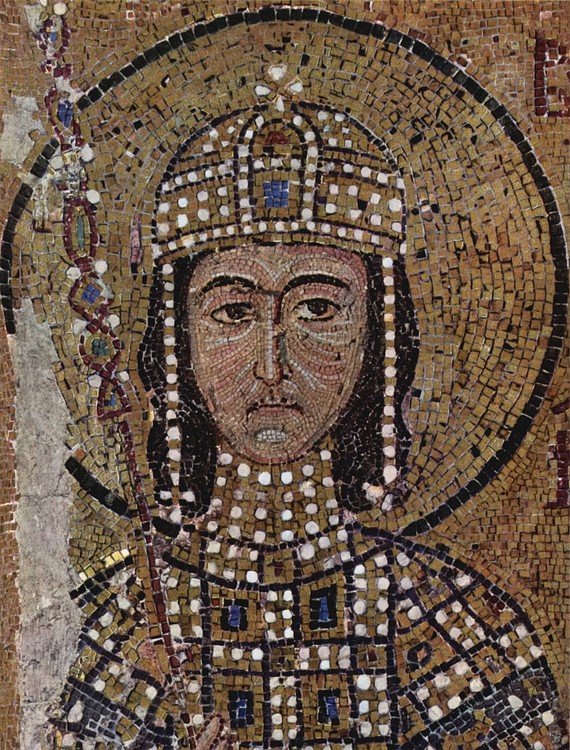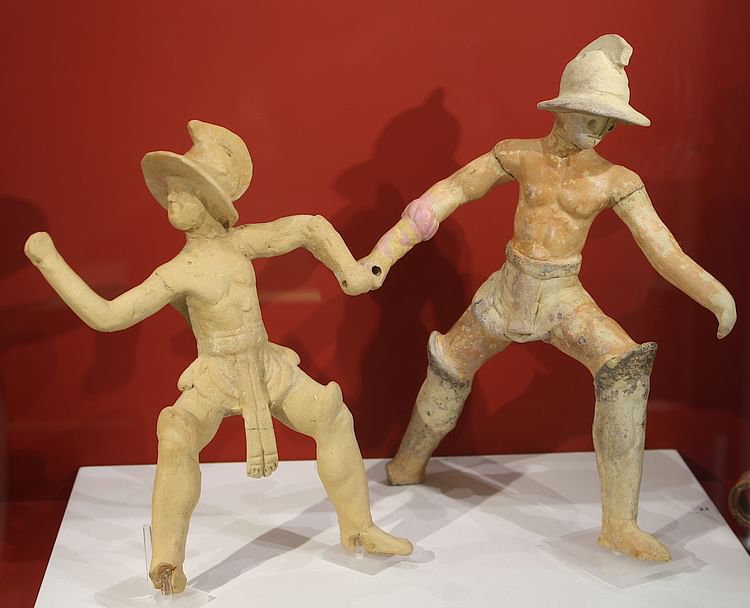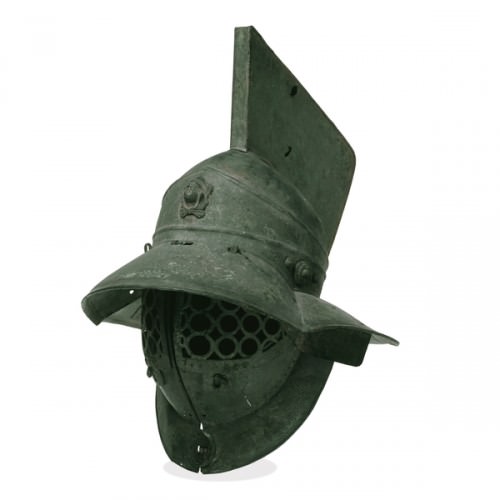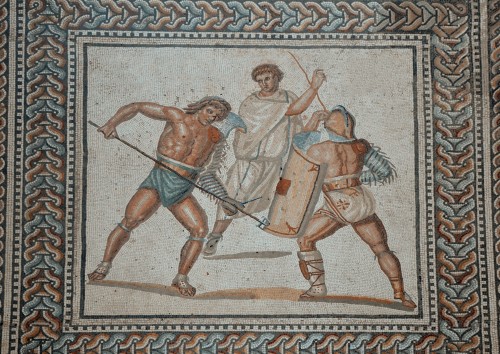Anna Komnene › Roman Gladiator » Ancient origins
Articles and Definitions › Contents
- Anna Komnene › Who Was
- Roman Gladiator › Antique Origins
Ancient civilizations › Historical and archaeological sites
Anna Komnene › Who Was
Definition and Origins

Anna Komnene (aka Anna Comnena, 1083-1153 CE) was the eldest daughter of Byzantine emperor Alexios I Komnenos(r. 1081-1118 CE) and the author of a lengthy biography of her father's reign, the Alexiad. Although not an impartial history, Anna's position at court, her thorough research of sources and a good measure of pithy observation and insightful opinion have all ensured the Alexiad remains one of the most important and colourful primary sources of Byzantine history.
EARLY LIFE
Anna Komnene was born in 1083 CE in the Porphyra, the purple room of the Byzantine royal palace in Constantinoplewhere royal babies were usually born and which was a potent symbol of royal legitimacy. She was the eldest daughter of Alexios I Komnenos and his wife the Empress Irene Doukaina. The emperor had no sons and so, for a time, Anna was the official heir following her betrothal to Constantine Doukas, the son of Michael VII (r. 1071-1078 CE). Constantine was nine years older than Anna and the empress-to-be later wrote of him in the following glowing terms:
[Constantine was] seemingly endowed with a heavenly beauty not of this world, his manifold charms captivated the beholder, in short, anyone who saw him would say, He is like the painter's Cupid (Herrin, 233)
Anna went to live with her future mother-in-law Maria of Alania where she was educated in mathematics, philosophy and medicine. A higher education was not regarded as becoming for a lady at court but Anna pressed ahead anyway and secretly hired Michael of Ephesos to tutor her in the more complex branches of philosophy, examining the works of Aristotle, in particular.
ANNA'S PROPERTY WAS CONFISCATED & SHE WAS PROHIBITED FROM EVER ENTERING THE ROYAL PALACE AT CONSTANTINOPLE AGAIN.
The path of Anna's future changed dramatically in 1087 CE when Alexios had a son, John, who became his chosen heir and the object of Anna's jealous hatred for the rest of her life. When Constantine Doukas died an early death in 1097 CE, Anna, still only 14, wasted no time and married the gifted general Nikephoros Bryennios the Younger. The couple would go on to have four children. She then plotted with her grandmother, Anna Dalassene, to make her new husband the next emperor. This plan failed, largely because Nikephoros remained loyal to the official heir John and stayed away when the rebels prepared to seize control of the palace.
When Alexios died of disease on 15 August 1118 CE, his son John became emperor John II Komnenos (r. 1118-1143 CE). It seems probable that Anna was involved in an assassination attempt aimed at John during their father's funeral, of all places, and within a year John had banished his scheming sister to the monastery of the Virgin Kecharitomene. All of Anna's property was confiscated and she was prohibited from ever entering the royal palace at Constantinople again.
BANISHMENT & THE ALEXIAD
At least Anna's forced seclusion allowed her to write her Alexiad (aka Alexias ) history in peace and, with what turned out to be a sentence of 35 years, time was not a problem. The Alexiad was begun c. 1137 (perhaps not coincidentally the year her husband died) and was worked on steadily through the mid-1140s CE. It covers the period of Byzantine history from 1069 to 1118 CE. Principally a tribute to her father and his 37-year reign, the work is the only such book written by a woman in the Middle Ages.
Consisting of 13 books written in Attic Greek, the Alexiad can be broadly divided into the following subject areas:
- Books I-III cover the rise of the Komnenos family and justify the clan's seizure of power.
- Books IV-IX cover various wars such as those against the Normans, Scyths, Turks and Cumans.
- Books X-XI cover the First Crusade (1096-1104 CE) and the 1105 CE Norman invasion of Byzantium.
- Books XII-XIII cover more military escapades and such domestic issues as the most infamous church heretics (eg the Manicheans and Bogomils).

Byzantine Hyperpyron of Alexios I
Anna used and referenced earlier works such as the Chronographia of Michael Psellos (1018 - c. 1082 CE) as well as official reports, treaties, archival records, eye-witness accounts from battles, hearsay, and the speeches and audiences she herself witnessed at court. Thus Anna's description of 11th century CE Byzantium, which covers not only major events but also many physical descriptions and other details such as protocols and clothing, has become an invaluable source for modern historians.Anna was also keen that her work present an objective view of events, although she herself admits the Alexiad is somewhat prejudiced, or at least an incomplete biography of her father, for the following reasons:
And truly when writing this, partly from the nature of history and partly because of the extravagance of the events, I forgot that it was my father's deeds that I was describing. In my desire to make my history free from suspicion, I often treat my father's doings in a cursory way, neither amplifying them nor investing them with sentiment. Would that I had been free and released from this love of my father, in order that I might have, as it were, laid hold upon the rich material and shown the license of my tongue, how much at home it is in noble deeds. But now my zeal is hampered by my natural love, for I should not like to afford the public a suspicion that in my eagerness to speak about my relations I am serving them with fairy tales! Indeed very often I recall my father's successes, but I could have wept my life away in tears when recording and describing the many ills that befell him, and it is not without private lamentation and plaint that I quit the subject. But no elegant rhetoric must mar this part of my history, and therefore I pass lightly over my father's misadventures, as if I were an insensible piece of adamant or stone…let my father's woes be a subject of marvel and lamentation to me alone. (Gregory, 291-2)
Certainly, Anna presents a glowing character portrait of her father whom she saw as 'a fiery whirlwind…radiating beauty, grace and dignity and an unapproachable majesty' (quoted in Norwich, 248). As an example of the rather exaggerated presentation of Alexios' great deeds - by no means an uncommon approach of historians of the period - Anna presents the following account of the emperor, in 1082 CE, defending himself with aplomb against three fierce Latin knights who:
…took long spears in their hands and at full gallop dashed at the Emperor. Amicetas missed the Emperor because his horse swerved a little; the second man's spear the Emperor thrust aside with his sword and then bracing his arm, struck him on the collarbone and severed his arm from his body. Then the third aimed straight at his face, but Alexios being of firm and steadfast mind was not wholly dismayed, but with his quick wit grasped in the flash of an instant the thing to do, and when he saw the blow coming, threw himself backwards on to his horse's tail. Thus the point of the spear only grazed the skin of his face a little and then, hitting against the rim of the helmet, tore the strap under the chin which held it on and knocked it to the ground. After this the Frank rode past the man he thought he had hurled from his horse, but the latter quickly pulled himself up again in his saddle and sat there calmly without having lost a single weapon. And he still clutched his naked sword in his right hand, his face was stained with his own blood, his head was bare, and his ruddy, gleaming hair was streaming over his eyes and worrying him, for his horse in its fright spurned the reins and by its jumping about tossed his curls in disorder over his face; however, he pulled himself together as much as possible and carried on his resistance to his foes. ( ibid, 292)

Alexios I Komnenos
Other prejudices revealed in the Alexiad include the typical Byzantine feeling of superiority over other cultures, as in this passage which describes the Franks :
[The emperor] heard a report of the approach of innumerable Frankish armies. Now he dreaded their arrival for he knew their irresistible manner of attack, their unstable and mobile character and all the peculiar natural and concomitant characteristics which the Frank retains throughout; and he also knew that they were always agape for money, and seemed to disregard their truces readily for any reason that cropped up. ( ibid, 295)
Still, in amongst the cliches of the dishonourable foreigner, there are more literary and more revealing passages of the times, for example:
And those Frankish soldiers were accompanied by an unarmed host more numerous than the sand or the stars, carrying palms and crosses on their shoulders; women and children, too, came away from their countries. And the sight of them was like many rivers streaming from all sides. ( ibid, 296)
DEATH & LEGACY
A woman wiser than men in words, more manly in acts, more firm in plans, more prudent in tests…a woman enriched by three eyes of perception, those of her natural perspicacity, of scientific penetration and of consummate experience (Herrin, 232).
Roman Gladiator › Antique Origins
Definition and Origins

A Roman gladiator was an ancient professional fighter who specialised with particular weapons and armur. They fought before the public in organised games held in large purpose-built arenas throughout the Roman Empire from 105 BCE to 404 CE (official contests). As fights were usually to the death, gladiators had a short life expectancy and so, although it was in some respects a glamorous profession, the majority of fighters were slaves, former slaves or condemned prisoners. Without doubt, gladiator spectacles were one of the most watched forms of popular entertainment in the Roman world.
ETRUSCAN ORIGINS
The Romans were influenced by their predecessors in Italy, the Etruscans, in many ways. For example, in the use of animal sacrifice for divining the future, the use of the symbolic fasces and organising gladiatorial games. The Etruscans associated these contests with the rites of death and so they had a certain religious significance. Although the first privately organised Roman gladiator contests in 264 BCE were to commemorate the death of a father, the later official contests discarded this element. Vestiges of the religious origins did, however, remain in the act of finishing off fallen gladiators. In this case an attendant would strike a blow to the forehead of the injured. The attendant would wear a costume representing Hermes the messenger god who escorted souls to the underworld or Charun (the Etruscan equivalent). The presence of the divine Emperor himself, accompanied by priests and the Vestal Virgins also lent a certain pseudo-religious air to the contests.
GLADIATOR GAMES WERE A BLOODY ENTERTAINMENT & THE GLADIATOR CONTESTS WERE LITERALLY A MATTER OF LIFE & DEATH.
KINGS OF ENTERTAINMENT
Roman gladiator games were an opportunity for Emperors and rich aristocrats to display their wealth to the populace, to commemorate military victories, mark visits from important officials, celebrate birthdays or simply to distract the populace from the political and economic problems of the day. The appeal to the public of the games was as bloody entertainment and the fascination which came from contests which were literally a matter of life and death. Hugely popular events were held in massive arenas throughout the Empire, with the Colosseum (or Flavian Amphitheatre ) the biggest of them all. Thirty, forty or even fifty thousand spectators from all sections of Roman society flocked to be entertained by gory spectacles where wild and exotic animals were hunted, prisoners were executed, religious martyrs were thrown to the lions and the stars of the show, symbols of the Roman virtues of honour and courage, the gladiators, employed all their martial skills in a kill or be killed contest. It is a popular misconception that gladiators saluted their emperor at the beginning of each show with the line: Ave imperator, morituri te salutant! (Hail emperor, we who are about to die salute you!), whereas, in reality this line was said by prisoners about to be killed in the mock naval battles ( naumachia ), also held in the arenas on special occasions.

Gladiator relief
Gladiators most often came from a slave or criminal background but also many prisoners of war were forced to perform in the arenas. There were also cases of bankrupt aristocrats forced to earn a living by the sword, for example Sempronius, a descendent of the powerful Gracchi clan. It is also of note that until their outlaw by Septimius Severus in 200 CE, women were permitted to fight as gladiators. There were special gladiator schools set up throughout the Empire, Rome itself had three such barracks and Capua was particularly famous for the gladiators produced there. Agents scouted the empire for potential gladiators to meet the ever-increasing demand and fill the training schools which must have had a phenomenal turnover of fighters. Conditions in the schools were similar to any other prison, small cells and shackles for all, however, the food was better (eg fortifying barley) and trainees received the best possible medical attention; they were, after all, an expensive investment.
THE THRACIAN GLADIATOR HAD A CURVED SHORT SWORD (SICA) & A VERY SMALL SQUARE OR ROUND SHIELD (PARMA).
ARMOUR & WEAPONS
The term gladiator derives from the Latin gladiatores in reference to their principal weapon the gladius or short sword.However, there were a wide range of other weapons employed in gladiator contests. The gladiators also wore armour and their helmets, in particular, were objects of great workmanship, richly embossed with decorative motifs and set with ostrich or peacock plumed crests. Weapons and armour though depended on which class a gladiator belonged to. There were four principal classes:
- The Samnite
- The Thracian
- The Myrmillo
- The Retiarius
The Samnite class was named after the great Samnite warriors that Rome had fought and beaten in the early years of the Republic. Interestingly, the Romans, at least in the early days, used gladiator and Samnite as synonyms, suggesting an alternative origin to Etruscan for these contests. The most heavily armed, the Samnite had a sword or lance, a large square shield ( scutum ) and protective armour on his right (sword) arm and left leg. The Thracian gladiator had a curved short sword ( sica ) and a very small square or round shield ( parma ) held in the fist to deflect blows. The Myrmillo gladiator was sometimes known as the fishman as he had a fish-shaped crest on his helmet. Like the Samnite, he carried a short sword and scutum but had armour only of padding on arm and leg. The Retiarius had no helmet or armour other than a padded shoulder piece and he carried a weighted net. He would try to entangle his opponent by throwing the net and then stab with his trident.
Gladiators fought in particular combinations, usually to provide a contrast between slower, more heavily armoured classes such as the Myrmillo against quicker, less protected gladiators such as the Retiarius. There were many other lesser types of gladiators with various combinations of weapons and armour and names changed over time, for example, 'Samnite' and ' Gaul' became politically incorrect when these nations became allies. Other types of combatants also included archers, boxers and the bestiarii who fought animals in the wild beast hunts.

Samnite Gladiator Helmet
WINNERS & LOSERS
Those who lacked enthusiasm to fight were cajoled by their manager ( lanista ) and his team of slaves who brandished leather whips or red-hot metal bars. No doubt the indignant roars from 40,000 spectators and the unrelenting attacks of one's opponent also convinced many to fight till the end. There were cases of refusal to fight: Perhaps one of the more famous was in the gladiator games organised by Quintus Aurelius Symmachus in c. 401 CE when the Germanic prisoners who were scheduled to fight decided instead to strangle each other in their cells rather than provide a spectacle for the Roman populace.
The losing gladiator, if not killed outright, often appealed for mercy by dropping his weapon and shield and raising a finger. His adversary could then decide to be lenient, although, as there was a significant risk of meeting again in the arena, it was considered good professional practice to kill your opponent. If the emperor were present then he would decide, although the crowd would certainly try to influence his judgement by waving cloths or gesturing with their hands - raised thumbs and shouts of Mitte! meant 'let him go', thumbs down ( pollice verso ) and Iugula! meant execute him.
Victors in the contests, particularly those with many fights behind them, became darlings of the crowd and as surviving graffiti on Roman buildings indicates, they were particularly popular with women - cases of affairs with aristocratic ladies and even elopement were not unknown. Graffiti from Pompeii gives a fascinating insight into how the gladiators were seen by the general public: Oceanus 'the barmaid's choice' or another was described as decus puellarum, suspirium puellarum (the delight and sighed-for joy of girls) and also written were how many victories some attained: Petronius Octavius 35 (his last), Severus 55, Nascia 60. However, it should be noted that the average was much lower and there were even some games in which victors fought other winners until only one gladiator was left standing. More material rewards for winning one's contest included the prestigious palm branch of victory, often a crown, a silver dish heaped with prize money and perhaps, after years of victories, even freedom.

Roman Gladiator Mosaic
EMPEROR COMMODUS (108-192 CE) WAS KEEN & MAD ENOUGH TO COMPETE HIMSELF IN THE GLADIATOR ARENA.
FAMOUS GLADIATORS
Perhaps the most famous gladiator of all was Spartacus, who led an uprising of gladiators and slaves from Capua, the leading producer of gladiators, in 73 BCE. From Thrace, the former Roman soldier had become a bandit until his capture and forced training as a gladiator. He and seventy comrades escaped from their training school and set up a defensive camp on the slopes of Vesuvius. Besieged, they then fled their position and rampaged through the countryside of Campania, collecting followers as they went and moulding them into an efficient fighting force. Battling his way north to the Alps, Spartacus displayed great military leadership in defeating four Roman armies on no less than nine occasions. Far from being a saint though, when a friend died in battle, Spartacus, in the old custom, arranged for three hundred Roman prisoners to fight gladiator contests in honour of his fallen comrade. After two years of revolt, the armies of Marcus Licinius Crassus finally cornered and quashed the rebels in Apulia in the south of Italy. As a warning to others, 6,000 of the prisoners were crucified along the Appian Way between Capua and Rome. Another consequence of this disturbing episode was that from then on, the number of gladiators owned by private citizens was strictly controlled.
Another famous gladiator was in fact a non-professional. Emperor Commodus (108-192 CE) was keen and mad enough to compete himself in the arena, indeed, there were even rumours that he was the illegitimate son of a gladiator. One might argue that Commodus was a professional as he made sure to draw a fantastic salary for his appearances in the Colosseum.However, it is unlikely that Commodus, usually dressed as Mercury, was ever in any real danger during the hundreds of contests he fought in the arena and his most frequent participation was as a slaughterer of wild animals, usually from a protected platform using a bow.

Commodus
THE END OF THE SHOW
Gladiator contests, at odds with the new Christian-minded Empire, finally came to an end in 404 CE. Emperor Honorius had closed down the gladiator schools five years before and the final straw for the games came when a monk from Asia Minor, one Telemachus, leapt between two gladiators to stop the bloodshed and the indignant crowd stoned the monk to death.Honorius in consequence formally prohibited gladiatorial contests, although, condemned criminals continued the wild animal hunts for another century or so. Many Romans no doubt lamented the loss of a pastime that was such a part of the fabric of Roman life but the end of all things Roman was near, for, just six years later, the Visigoths led by Alaric would sack the Eternal city itself.
LICENSE:
Article based on information obtained from these sources:with permission from the Website Ancient History Encyclopedia
Content is available under License Creative Commons: Attribution-NonCommercial-ShareAlike 3.0 Unported. CC-BY-NC-SA License